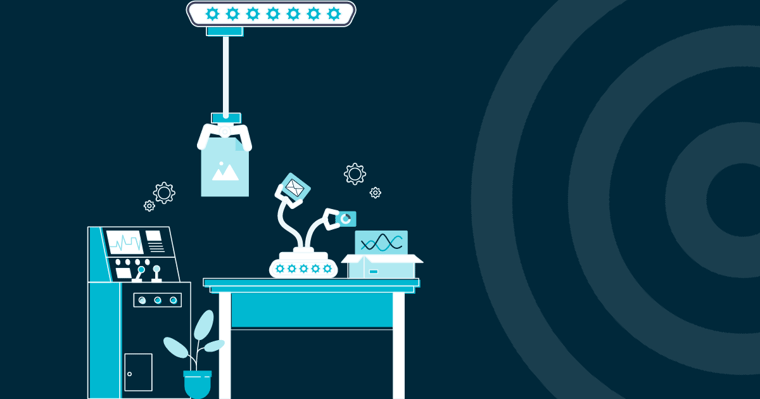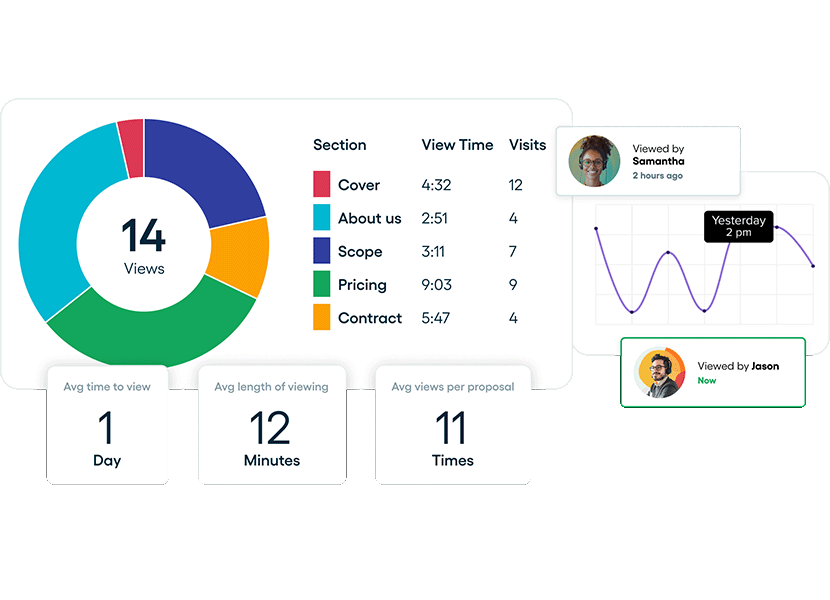
How is your sales team creating and sharing proposals right now? Word documents? PDFs? That probably means they're creating every new proposal from scratch, taking up a lot of time they could be spending finding new prospects and closing new deals.
There's an easier way. Proposal automation can streamline the sales process from beginning to end, saving your team time and standardizing the way they create and send proposals. It's the solution you didn't know they needed.
What Is Proposal Automation?
Proposal automation is the process of streamlining and optimizing the creation, customization, and delivery of sales proposals through the use of specialized software solutions.
Put simply, it takes the complex, time-consuming manual proposal process and automates it with software.
If your proposal creation process takes too long, you run the risk of the deal going cold. For our State of Proposals 2024 report, we studied more than 1.2 million proposals created with Proposify, and found that the average time to create a proposal is 17 minutes.

How does that compare to how long it takes your team to manually create proposals? How many more proposals could they be sending if they automated the process?
Proposify CEO and Co-Founder Kyle Racki says,
Usually, one of the biggest problems customers want to solve when they come to Proposify is that there's too much manual work going on that's eating up their reps' time.
With proposal document automation, you and your team can leverage templates, predefined content blocks, and dynamic pricing tools to generate personalized proposals tailored to each prospect's needs and save time doing it. This can lead to improved productivity and higher close rates.
By integrating with business management tools, proposal process automation software makes it easier for departments to share information and work together. This helps sales, marketing and other teams involved in the sales process stay on the same page and work more smoothly.
You can find more statistics and insights about proposals in the State of Proposals report.
Proposal Automation Software Features
Proposal automation software typically offers a range of features designed to streamline and optimize the proposal creation and management process. Here's the proposal automation technology to look for when choosing a solution.
Template Library
This is a repository of customizable templates you and your team can use as a foundation for creating proposals, saving time and ensuring consistency across documents. It also means you won't be starting from scratch for every proposal.

It may also be possible to lock these templates to prevent sales team members from making unauthorized changes to the design, contract stipulations, or pricing.
Content Library
This centralized database holds pre-approved content blocks, such as product descriptions, case studies, and testimonials. They can be inserted into proposals to personalize and enhance their effectiveness.
A content library saves sales reps time from having to write proposal content from scratch while ensuring consistency and accuracy across documents.
Dynamic Pricing
Pricing can make or break a deal. Dynamic pricing tools enable sales professionals to generate accurate pricing quotes based on configurable parameters, such as discounts, quantity breaks, and optional add-ons.
With dynamic pricing, your team can tailor their proposals to meet potential customers' unique needs and budgets, increasing the chances of closing deals.

Collaboration Tools
Proposal automation software makes it easier for your team to collaborate, allowing for real-time editing, commenting and version tracking.
This safeguards that every proposal that goes out the door meets the requirements and standards of all stakeholders, including the marketing, legal and finance departments.
Proposal Analytics
Knowledge is power. Proposal analytics provide insights into proposal performance, including metrics such as open rates, engagement levels, and conversion rates, enabling your team to refine their strategies, optimize future proposals and make data-driven decisions.

Integration with CRM Systems
Sales proposal automation software should integrate with customer relationship management (CRM) systems, allowing sales team members to automatically populate proposal templates with prospect data, and track proposal status.
They can also synchronize proposal activity with sales pipelines for improved visibility and reporting. With CRM integration, you can streamline the sales process and ensure that no opportunity falls through the cracks.
E-Signature Integration
Integration with electronic signature solutions enable clients to sign proposals digitally, accelerating the approval process and minimizing administrative overhead.

Once you've decided to automate your proposals, the next step is to empower your team to put the solution into action.
How Sales Teams Can Use Proposal Automation Tools
Your team will find several proposal automation benefits that enhance productivity, and improve the effectiveness of their sales efforts.
Automate Content Based on Lead Information
Let's say you're a professional services business. You might have a lead gen form, and your prospects have to fill out fields. Name, company, etc. Reps are often manually copying and pasting this information, performing a find and replace on client names.
This opens the proposal up to errors. Few things are more embarrassing to a rep than a proposal sent with the wrong name attached to it. To the prospect, it looks like carelessness and lack of attention to detail. And if that's lacking in the proposal, in their mind, it stands to reason it would also be lacking in the product or service.
Instead, you could automate the process. Kyle says,
Based on those lead gen form fields, you could generate a proposal document in draft form that includes the information that person has provided.
This not only does away with the need for manual copying and pasting, but reduces the likelihood of errors in prospect contact information, and makes it more likely the sales process will continue to move forward.
Automate Payment
Most larger companies have sophisticated invoicing processes in place. But for smaller companies, it can be easier to have the new client pay for the deal—or at least a deposit—through an automated integration within the proposal.
This can usually be accomplished by integrating with Stripe or other similar payment gateways. This way, Kyle explains,
Even if the prospect signs the proposal and essentially agrees to the deal, it's not closed until the deposit is paid.
Generate a Contract After a Proposal is Accepted
At Proposify, we often advise our customers to bake the terms and conditions or the statement of work right into the proposal. So when the prospect looks at the proposal, they're seeing all the content in one place. Kyle says,
You want to remove as many steps as possible, so putting the contract in the document itself makes it easier for them to sign off.

However, this isn't always possible for a company. Sometimes it's necessary to have two separate documents, and send the contract once the proposal has been accepted. This is a perfect use for automation.
What you can do is, after the proposal is signed, generate a contract from a template that populates all the information so that there's minimal work required from the rep to send the contract out for signature.
Kyle says.
Create a New Project and Client After a Proposal is Signed
If you're a service-based business, you're probably using Asana, Teamwork or some other project management tool. Once a proposal is signed, it's another copy-and-paste effort to get the new client's project information loaded into the tool. It's a lot of manual work, and it leaves too much room for error.
Instead, you could automate the process. Once the proposal is signed, the client's information can be automatically moved into the project management tool so your team can get started on the work the prospect has just agreed to.
Automate Renewals
Usually, the sales focus is on closing new business and getting that initial contract over the line. But some businesses often deal in recurring services and recurring revenue. For example, if you're a SaaS company, you may have annual or even two- or three-year contracts. This is an area where automation can make your life a lot easier.
Kyle says,
Often, it's a separate team dealing with contract renewals, like an account management team. Instead, you can set up the software to know that after a designated period of time, another contract needs to be generated.
The software can then notify the account manager that the contract is ready for renewal so they can get ahead of any potential churn or cancellation.
Automate File Storage
This one is pretty simple, but it's surprising how many businesses don't take advantage of it. The manual file storage process usually means a rep downloads a signed contract as a PDF, then uploads it somewhere.
Instead, you could automate the process. When a contract is signed, proposal automation software can upload it to your CRM, Dropbox, Google Docs, or wherever you're storing your files.
This is really useful from a CRM perspective. If anyone at any point in the customer lifecycle wants to see what the customer actually signed off on, they can easily find the document.
Kyle says.
Automate Follow-Up Emails or Texts
Proposify offers a feature that allows a rep to input a number of days that need to go by before a proposal follow-up is sent. The feature automatically shuts off once the proposal is viewed the first time.
But what about internal notifications? Maybe a rep sends a proposal, the prospect views it, but then the rep doesn't hear back. Proposal automation software could send notifications to the rep reminding them to follow up, or to mark the deal as lost after a certain amount of time.
Scott Tower, Proposify's Director of Sales, adds
Another use for this automation is to connect the notifications to your sales engagement platform. The account manager can be notified that the prospect hasn't viewed the proposal after a certain number of days, which triggers a task in Apollo, Salesloft or whatever platform you're using, and this can help get the follow-up done.
Automate Expirations
Say you send a prospect a proposal, and they don't respond. You write the deal off as lost and move on. Then, a year later, the prospect comes back. Your prices have changed, but the prospect wants you to honor the original terms of the old proposal.
Rather than being locked into an outdated agreement, you can use proposal automation to set an expiration date. Instead of you just adding a bit of text in the proposal, the software can send a warning notification to the prospect when the proposal is about to expire. You can even go so far as to make the proposal inaccessible upon expiration.
Scott adds,
The key to proposal expirations is also communicating it verbally when you're running through the proposal with the prospect because you don't want them to be caught off guard, and you want to be transparent.
Setting an expiration date will prevent any future disputes about terms, but also create a sense of urgency to help nudge the prospect into action.
Trigger an Approval Workflow if a Deal or Discount is Above a Certain Size
It's no secret that reps can sometimes go rogue and offer deal terms or discounts that haven't been preapproved by the company. But sometimes, they may just be working a deal that's unusually large for the organization. In those cases, you can have proposal software trigger an approval workflow.
This means before the proposal can actually be sent, it goes to the appropriate manager or stakeholders for review. Then, once it's approved—or changed—the proposal can go out to the prospect.
Scott adds,
Before it even gets to that point, though, you want to have everyone internally aligned on the pricing, especially for bigger opportunities. The beauty of Proposify is you can see drafts earlier on. If you have a big deal, be involved early as a sales leader.
Change the Deal Stage Based on Proposal Activity
The most obvious example of this is when your proposal is accepted, you update it to reflect that. But there are other ways to take advantage of this automation.
Just creating the proposal could trigger the opportunity to move to the proposal stage. Conversely, when the opportunity stage changes, your proposal automation software could automatically generate a proposal.
Kyle points out,
Every company is different, and sometimes, they want the CRM to be the trigger and the proposal to be the action. But sometimes, it's the opposite.
Scott agrees. He says
Stages in the CRM is something reps can easily forget to update. So any time you can take that manual action off a rep's plate and replace it with an automation, it's good.
Generate an Invoice When the Proposal is Accepted
When a proposal is accepted, your financial team is going to have to look at that proposal, look at the quote or pricing table, and then recreate all of it in their invoicing software. Why not generate an invoice that has the table already built with whatever the buyer selected—there could be upsells or adjusted quantities—and have that automatically go into the invoice so it's accurate?
Proposal automation software can integrate with financial platforms to accomplish this. For example, Proposify integrates with QuickBooks, FreshBooks and Wave.
Kyle says,
We sometimes hear financial teams say that they're looking at software like Proposify because what ends up in the accounting isn't always reflective of what the sales rep sold. There may be discounts in place that aren't reflected in the CRM, which means they don't make it into the invoice. So automation is a way to keep everything accurate and avoid potential human error.
In short, your sales team can leverage proposal automation tools to streamline their workflow, improve collaboration, personalize proposals, maintain accuracy and ultimately, close more deals, more quickly and efficiently.
Proposify can do all of this and much more.
Proposify Automations
To make all of this possible, Proposify has launched a new feature called Proposify Automations. This powerful tool allows you to eliminate time-consuming and error-prone manual tasks with efficient, accurate automations.
You can use pre-built automations, or build custom automations with the help of our Workflow Builder.
Proposify Automations works with hundreds of third-part applications, including:
- Slack
- Microsoft Dynamics 365
- Salesforce
- HubSpot
- QuickBooks
- Calendly
- DocuSign
And many more!
It's currently free with all plans, so schedule a demo to see it in action.
Automate Your Sales Proposal Process
When you're ready to move forward with a proposal automation solution, consider Proposify. It's proposal software that includes all the features you need to streamline your sales process, and it gives your team all the tools they need to close deals more quickly and efficiently.
Once you and your team have tried it, you'll wonder how you ever made a sale without it.
Schedule a demo today to learn how Proposify helps you automate the proposal process while giving you end-to-end visibility into and control of it.

Michelle Lowery is a B2B and B2C writer and editor with more than 15 years of experience. She believes empathy is the key to high-performance content. Connect with her on LinkedIn:



